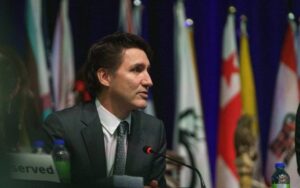
As of 2023, the average Canadian family spends 43 per cent of its income on taxes, as compared to 35.6 per cent on food, shelter and clothing combined. Pictured: Prime Minister Justin Trudeau. Photo Credit: Justin Trudeau/X.
The amount of attention being paid to the latest report on taxation in Canada from the Fraser Institute is interesting as its overall conclusion is not new. The report is the latest update of a regular publication produced by the Institute on the tax burden of Canadians as compared to other major expenditures of households. The glaring headline which has captured the media’s attention is that Canadians are now paying more in taxes than the total spent on the necessities of food, clothing and shelter.
Although this is a finding worth publicizing, it is not news. In fact, Canadians’ biggest expenditure for years has been the sum total of all taxes levied by governments. What this study did differently from previous studies was present data over a long period of time, from 1961 to 2023. In 1961, Canadian expenditures on taxes were actually less than their spending on necessities, proving that our huge spending on taxes was not always a Canadian reality.
The study found that from 1961 to 2023, the amount of total taxes paid by the average Canadian family increased by 2,705 per cent – more rapidly than the growth in any other single expenditure area. For instance, spending on shelter increased by just over 2,000 per cent, food by 901 per cent and clothing by 478 per cent. The overall Consumer Price Index tracked by Statistics Canada increased by 901 per cent, still much less than the growth in taxes.
As of 2023, the average Canadian family spends 43 per cent of its income on taxes, as compared to 35.6 per cent on food, shelter and clothing combined. In 1961, the comparable numbers are 33.5 per cent on taxes and 56.5 per cent to necessities. Around 1992, the amount Canadians were paying for necessities versus taxes was roughly equal, but from there the large growth in taxes consistently outstripped spending on the basics.
A key consideration is whether Canadians believe they are getting significantly more value for the increased amount they are paying for government services. A number of new social services came into being in the 1960s that did not exist previously, and all added to the average Canadian’s tax bill. For instance, CPP came into force in 1966 and all indications are that the CPP pension program is valued by the majority of Canadians. A universal health care system was present in some provinces prior to 1961, but really came into its own on a national basis in the 1960s and 1970s, and continued to be subject to major changes in subsequent years such as when the federal Liberals drastically cut transfers to provinces for health, education and other social programs to fight Canada’s debt crisis in the mid-1990s.
A majority of Canadians support these added social services so that is one explanation for higher proportional tax levels. However, recent years have shown a deterioration in many of Canada’s social programs despite ongoing increased taxes and a very large increase in the federal government in particular over the last few years under the Trudeau government. It will be informative to see in a few years’ time whether Canadians believe their high tax levels and a much larger and more costly federal government are delivering value for money. Considering current trends, it doesn’t seem likely that most Canadians will buy into this.
International studies have shown that high tax levels can be accepted if the population believes they are getting value for taxes paid and also that they have some kind of input into taxation policy. Some European countries, for example, conduct referenda on whether a tax should be raised or not, and whatever the decision the electorate at least believes they were given an opportunity to express their views so will be more accepting of the ultimate decision. Canadians have virtually never enjoyed that type of consultation.
The policy preferences of the Trudeau Liberals are also more expensive from a tax administration standpoint than some alternatives. For example, the preferred way to impose a carbon tax if a government is so inclined is to impose the tax but offset the tax revenue by reductions in income taxes so that the tax overall will be revenue neutral. This would be the most efficient and low-cost way to apply such a tax. But the Trudeau government does not believe it will be given credit for any income tax reductions as they tend to be buried in Canadians’ paycheques, so it has chosen to cycle the carbon tax money raised through an expensive government bureaucracy that then returns an amount to Canadians via a rebate that shows up on their bank account, so the rebate can be clearly perceived as having come from the government. This is very inefficient and expensive, and considering the views of Canadians, doesn’t seem to have won the Liberals any friends despite their fervent efforts to encourage Canadians to be grateful for the crumbs they have been rebated.
Another important consideration is how the overall tax level affects our economic competitiveness. Some recent comparative studies with the US, our major trading partner, have shown that Canada remains uncompetitive from a tax standpoint for both businesses and individuals. Our lowest tax jurisdiction in Canada – Alberta – still has a higher total tax level than the US’s highest tax jurisdiction – California. And Americans are fleeing California because of their high taxes. Go figure. Our high rates of personal taxes at the income levels for professionals, entrepreneurs, doctors, engineers and other relatively high earners means that we are driving away the very people we need to keep in Canada to build our economy and create jobs.
The fact this latest Fraser report received much more attention than its predecessors is a positive, as we are overtaxed in Canada and it is hurting families and our competitiveness as an economy. The massive growth in the federal bureaucracy under Trudeau has worsened the tax situation as, in any government, at least 50 per cent of the expenditures go to employee compensation. Other research has also demonstrated that most government employees are paid more than their private sector counterparts, and received gold-plated pensions and other expensive benefits on top of that, further increasing the cost of growing government.
The approach of leftist governments is usually to overtax their citizens and then return small portions of that money in the form of programs such as child benefits, carbon tax rebates, etc., and expect everyone to be grateful for small mercies. All of these programs have a cost attached and swell the government bureaucracy. A conservative approach is to lower everyone’s income taxes so families and others can make their own decisions as to how to spend their own money. We’re at the point in Canada where the conservative approach, which is much more efficient in terms of administration, is what we need to downsize the bloated bureaucracy and let Canadians keep more of the money they earn to spend as they choose.

She has published numerous articles in journals, magazines & other media on issues such as free trade, finance, entrepreneurship & women business owners. Ms. Swift is a past President of the Empire Club of Canada, a former Director of the CD Howe Institute, the Canadian Youth Business Foundation, SOS Children’s Villages, past President of the International Small Business Congress and current Director of the Fraser Institute. She was cited in 2003 & 2012 as one of the most powerful women in Canada by the Women’s Executive Network & is a recipient of the Queen’s Silver & Gold Jubilee medals.




















